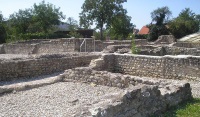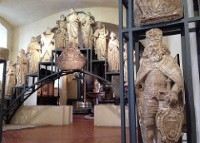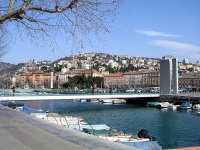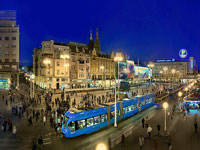
Near the village of Scitarjevo, close to Zagreb, are the remains of the excavated ancient Roman town of Andautonia. Andautonia was a prominent administrative, economic, cultural, and religious centre about 400 years ago.Archaeologists are still excavating the site. However, at the Andautonia Archaeological Park, visitors can view a 26,910-square-foot (2,500 sq m) area of the Roman City, including parts of the main street, city baths, colonnades, and side streets.There is a museum at the site which exhibits artefacts from the Greek and Roman periods. Additionally, tourists can also visit the present-day village of Scitarjevo to get a glimpse into rural life and see some traditional wooden housing.
Address : Archaeological Museum: 19 Nikola Subic Zrinski Square
Website : www.amz.hr

The building that houses Croatia's history is itself a part of that history. Situated in the historical town centre, it is the beautiful Baroque palace, Vojkovic-Orsic-Rauch, built at the end of the 18th century and formerly the private residence of three successive baronial families. In the late 1930s the palace became the residence of Zagreb's mayors, before being designated as a repository for the historical relics of the city. It currently houses more than 140,000 artefacts in various collections, from stone monuments to fine art, religious artefacts to heraldry.The exhibitions in this museum are not permanent but constantly changing so that all the collections get an airing. This means that it is possible to visit the museum many times and never tire of the exhibitions. The artefacts are grouped into 17 collections which include maps, coins, religious items, stone mouments and military uniforms, among other thing. Despite being quite a small museum the exhibits are well-curated and interesting.
Address : Matoševa 9
Website : www.hismus.hr/en
The building housing the Croatian National Theatre (or HNK Zagreb) is as much a national treasure as the world-class theatre, opera, music, and ballet productions that take place on its stage. Construction began on the theatre building in 1894, with Croatian artist Vlaho Bukovac painting the ceremonial curtain while Viennese artist Alexander Goltz decorated the ceiling of the auditorium.The building was officially opened by Austro-Hungarian emperor Franz-Joseph I at the end of 1895. The theatre is owned and operated by the Croatian Ministry of Culture and it is constantly busy with full performing arts programmes. At the entrance to the theatre visitors can see the famed wall fountain called 'The Source of Life', designed by Croatian artist and sculptor Ivan Meštrovic in 1905.The Croatian National Theatre has hosted famous artists and performers from all over the world and culture vultures shouldn't miss seeing a show. If travelling with a group, the mezzanine boxes are a wonderful way to experience the performances together. It's worth taking a walk by simply to admire the building even for those who don't have the time to catch a performance at the venue itself.
Address : Trg Marsala Tita 15
Website : www.hnk.hr/en

The largest island in Croatian archipelago, Krk is a haven of sparkling beaches and lovely holiday towns. Nicknamed the 'Golden Island', Krk is the nearest Croatian island to mainland Europe and has a laidback Mediterranean atmosphere.Getting to Krk from the mainland is made easy by a 4,500-foot (1.4km) bridge. Once there, visitors are spoiled for choice as there are many beaches and villages to explore. Krk Town is the largest and most popular hub for tourists with many restaurants, shops, and bars in the attractive Old Town area.The best beaches are found in Baska, which boasts more than 30 beaches connected by a promenade. Though most are covered in pebbles, soft mats and chairs are available for hire. Other popular beach towns on Krk include Njivice and the sandy coastline of Klimno Bay, though often these towns have more to offer than just beaches. Vrbnik is home to vineyards that produce some of the best white wines in Croatia, while the August folk festival in Dobrinj draws crowds from all over the country.Krk Island is popular for weekend excursions from the Croatian mainland. However, visitors can easily spend a week exploring the winding streets and hidden corners of the island. A haven for watersports, diving, bird watching, and hiking, there is lots to see and do on Krk for just about anyone.

The Plitvice Lakes have been declared a UNESCO World Heritage Site and the national park that encloses them is the oldest in Southeast Europe. It is the natural beauty of the 16 green and turquoise lakes, linked by waterfalls and surrounded by forests, attracts thousands of visitors every year.Wooden walkways meander over, around and across the magical watery setting that was formed by mineral deposits in the water creating travertine barriers within the constantly changing limestone landscape.The lakes are divided into lower and upper lakes and trails are well marked. Visitors can cover the 11 miles (18km) of walkways on foot, but the park entry ticket also includes the use of buses and ferries that cover certain sections.The incredible lakes are not all the park has to offer; it is a heavily forested area with an extremely diverse variety of flora and fauna, including rare European species like the brown bear and wolf. It is one of the last regions in Europe in which these two species can be found living in the wild.
Website : www.np-plitvicka-jezera.hr/en

The commercial capital of the idyllic Adriatic Coast is the cultural city and holiday destination of Rijeka, with its international harbour lending it a cosmopolitan flair. Rijeka is not only the gateway to the beautiful coastal island resorts, but a tourist's delight in itself with its charming historic buildings.A stroll along the Korzo Promenade in the old part of town provides an eyeful of classic buildings and a variety of street cafes ideal for resting your feet and enjoying the passing parade. Rijeka also has an annual carnival full of lively music and dancing, providing a glimpse into ancient Slavic folklore and mythology. Revellers don masks to scare away evil forces and there are numerous events, concerts, and the carnival parade.There is plenty to eat, drink, see, and do in this vibrant port city. The best way to see Rijeka's cultural and historical attractions is to follow the well-worn tourist path that takes in all of the most important sights of the town.Most of them are accessible by foot, as they are located in or near the city centre. To see Rijeka's remarkable Trsat Castle, visitors need to grapple with some formidable stone steps. But it is certainly worth the climb.

Praska Street, in the lower part of old Zagreb, leads on to a sequence of attractive park squares, each flaunting their own attractions and worth a walking tour. Zrinski Square features a music pavilion dating from 1895 and fountains, with the Archaeological Museum at No.17.This square also features a row of busts of distinguished Croatians and the palace of the Croatian Academy of Arts and Sciences, which houses the Strossmayer Gallery. On Strossmayer Square is a monument to Bishop Josip Juraj Strossmayer, founder of the academy, as well as several other historic buildings.Tomislav Square features the Art Pavilion, fronted by a monument to Croatian Renaissance painter Andrija Medulic. King Tomislav rises on horseback at the southern end of the square. Starcevic Square is home to the City Library and Hotel Esplanade, and gives access to the Botanical Gardens and Frane Bulic Monument.In Marulic Square, the University Library building stands as a magnificent example of Art Nouveau architecture. Mimara Museum is on Roosevelt Square, and the neo-Baroque Croatian National Theatre stands on Marshal Tito Square. Any or all of these squares are worth a visit so it is best to take a leisurely stroll around them all with camera in hand.
Trakoscan is a legendary 13th-century Gothic castle that was home to various influential families for centuries before finally falling into abandoned disrepair in the second half of the 18th century, when it belonged to the Draskovic family.In the 1950s, the castle was taken over by the state and turned into a living museum, reconstructing life in a medieval castle. Visitors can explore four levels, including the dungeon, and finish their tour with a stroll through the surrounding parklands.Trakoscan Castle is a spectacular journey for the imagination as it feels so authentic. Guests can wander with freedom through the stone corridors, up and down the winding staircases, and into the various rooms. It is also a great attraction for the younger children as the castle, lake, and forest settings transport the little ones to a fairytale world.The castle features original artefacts from its history, including furniture and weaponry, and displays are informative and well laid out. As wandering through the castle, and its beautiful grounds, can be somewhat tiring, visitors often stop for a break at the restaurant by the lake.

Travel Guide powered by Word Travels, copyright © 2023 Globe Media Ltd. By its very nature information in this travel guide is subject to change at short notice and travellers are urged to verify information on which they're relying with the relevant authorities. Neither Globe Media Ltd nor Travel Vogue can accept any responsibility for any loss or inconvenience to any person as a result of information contained above.